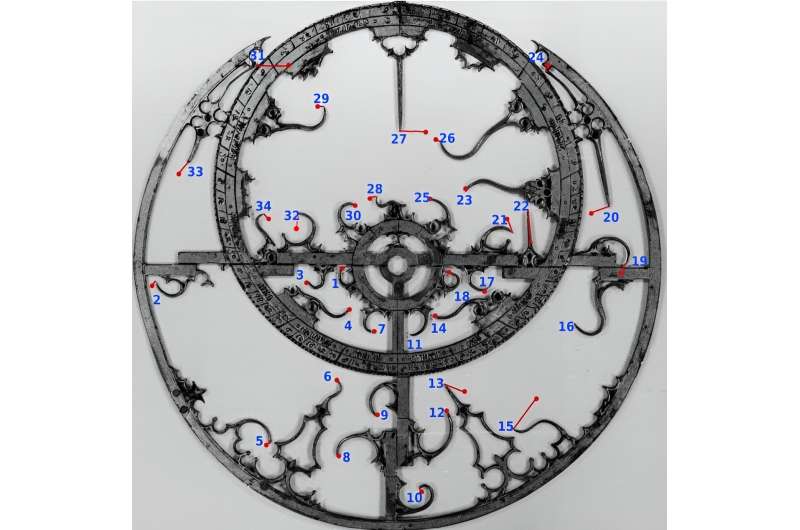This article has been reviewed according to Science X's editorial process and policies. Editors have highlighted the following attributes while ensuring the content's credibility:
fact-checked
preprint
trusted source
proofread
The positions of stars on an ancient navigation device tell us when it was made

Astrolabes serve two purposes. First, they are useful as an astronomical tool, especially for finding a ship's latitude. But second, they are works of art in themselves. Besides having to be precise, many are beautiful. They are even seeing a resurgence in popularity as collectors lap up even those made by modern manufacturing processes because of their aesthetic appeal.
Now, a new paper adds to their uses—a self-referential ability to mark what year they were made by the patterns of the stars they reference.
Emmanuel Davoust is a professional astronomer at the Observatorie Midi-Pyrenees in Toulouse, France. He's also somewhat of an amateur historian. In a paper recently released on the arXiv preprint server, he analyzes the positions of stars as where they would be with reference to the pointers on an astrolabe located in the Musee des Arts precieux Paul-Dupuy, also in Toulouse.
Constructing an astrolabe is a complicated process and requires the manufacture of several parts with arcane names such as the "rete," which "represents a planar projection of the celestial sphere," and the "mater"—not referring to the animated Disney character, but the disk with graduations on the back that allow the user to determine a star's height over the horizon.
But perhaps most importantly, astrolabes have "pointers" that, when placed against the sky, would represent the position of a particular set of stars. The astrolabe Dr. Davoust studied has 34 of these, though none are named.
The solution to understanding what stars are at the end of the pointers might seem simple—hold the astrolabe out at different places in the sky until all 34 pointers point at something (and at Polaris—which must be located in the center of the rete). However, despite seemingly staying stationary in the night sky, stars do move over long periods—for example, over centuries.
That slow, drifting movement is what Dr. Davoust used to date the astrolabe. Since the astrolabe lacked an obvious take of manufacture from the Dominican friars who made it, and none of the stars at the end of the pointers were named, it was time to bring modern technology into the effort.
Dr. Davoust took a picture of the rete and tried to determine the coordinates of each of the 34 pointers. He then cross-referenced a star catalog that showed the position of all reference stars used on other known Latin astrolabes and tried to find the pattern closest to what was seen on the rete of the one he was studying. For an added layer of control, he limited the search between the years 1400 and 1700, with a step function of 50 years, and only on the date of the equinox for each year.
He found that the equinox of the year 1550 was the closest to having referential stars near the end of the pointers on the Toulouse astrolabe. It didn't line up quite precisely, but it was likely close enough to be helpful to the friars for whom it was initially designed.
This bit of historical sleuthing using astronomy shows how cross-disciplinary research can bear unexpected fruit, even if that fruit is as simple as understanding when an object that is now only an impressive museum piece was built.
More information: Emmanuel Davoust, Dating of a Latin astrolabe, arXiv (2023). DOI: 10.48550/arxiv.2311.17966
Journal information: arXiv
Provided by Universe Today





















